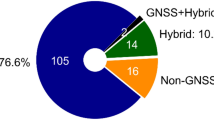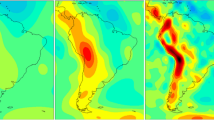Abstract
Chandrayaan-2, India’s second Moon mission, comprised of Orbiter, Lander and Rover modules was launched on July 22, 2019. The Chandrayaan-2 (CH2) Orbiter, which carries eight scientific payloads, is placed into a circular lunar orbit of 100 km altitude with an orbital period of around 120 minutes. After the successful injection of the spacecraft in the intended Earth parking orbit, it started facing eclipses during the Earth bound, Trans lunar, and lunar phases. This paper describes a high-fidelity orbit prediction propagator known as the Satellite Precise Orbit Propagator (SPOP), and an Earth shadow eclipse prediction model: the projection map method for the lunar orbiting spacecraft. The orbit and eclipse prediction models are simulated for the CH2 Orbiter. Results obtained by the models compare well with globally popular commercial package, Systems Tool Kit (STK) of Analytic Graphic Inc.






Similar content being viewed by others
References
Jacobson, R.A., Konopliv, A.S., Park, R.S., Folkner, W.M.: The rotational elements of Mars and its satellites. Planet. Space Sci. 152, 107–115 (2018)
JPL SPICE NAIF Toolkit, https://naif.jpl.nasa.gov/naif/toolkit.html. Accessed Dec 2018
Konopliv, A.S., Asmar, S.W., Carrranza, E., Sjogren, W.L., Yuan, D.N.: Recent gravity models as a result of the Lunar Prospector mission. Icarus 150, 1–18 (2001)
Li, Z., Ziebart, M., Bhattarai, S., Harrison, D.: A shadow function model based on perspective projection and atmospheric effect for satellites in eclipse. Adv. Space Res. 63(1), 1347–1359 (2019)
Mathavaraj, S., Negi, K., Vaibhav, G.: ISRO’s unprecedented journey to the Moon. Acta Astronaut. 177, 286–298 (2020)
Montenbruck, O., Gill, E.: Satellite Orbits: Models, Methods, and Applications. Springer, Berlin (2005)
Oraevskii, V.N., Kuznetsov, S.N., Malyshev, V.V., Usachov, V.E., Tychinskii, Y.D.: A study of a possible method of observing solar eclipses from satellite orbits. Cosm. Res. 42(1), 23–31 (2004)
Song, Y.J., Kim, B.Y.: The effect of the Earth’s oblateness on predicting the shadow conditions of a distant spacecraft: application to a fictitious lunar explorer. Adv. Space Res. 57, 355–366 (2016)
Srivastava, V.K., Srivastava, A., Pitchaimani, M., Chandrasekhar, B.S.: Eclipse prediction methods for LEO satellites with cylindrical and cone geometries: a comparative study of ECSM and ESCM to IRS satellites. Astron. Comput. 2, 11–17 (2013)
Srivastava, V.K., Srivastava, A., Roopa, M.V., Ramakrishna, B.N., Pitchaimani, M., Chandrasekhar, B.S.: Spherical and oblate Earth conical shadow models for LEO satellites: applications and comparisons with real time data and STK to IRS satellites. Aerosp. Sci. Technol. 33, 135–144 (2014)
Srivastava, V.K., Yadav, S.M., Srivastava, A., Kumar, J., Kushvah, B.S., Ramakrishna, B.N., Ekambram, P.: Earth conical shadow modeling for LEO satellite using reference frame transformation technique: a comparative study with existing earth conical shadow models. Astron. Comput. 9, 34–39 (2015a)
Srivastava, V.K., Kumar, J., Kulshrestha, S., Srivastava, A., Bhaskar, M.K., Kushvah, B.S., Shiggavi, P., Vallado, D.A.: Lunar shadow eclipse prediction models for the Earth orbiting spacecraft: comparison and application to LEO and GEO spacecraft. Acta Astronaut. 110, 206–213 (2015b)
Srivastava, V.K., Mishra, P., Ramakrishna, B.N.: Satellite ephemeris prediction for the Earth orbiting satellites. Aerosp. Syst. (2021). https://doi.org/10.1007/s42401-021-00092-z
Vallado, D.: Fundamental of Astrodynamics and Applications, 4th edn. Microcosm, Hawthorne (2013). 4th edn. Space Technology Library, Microcosm Press and Springer (2013)
Vokrouhlicky, D., Farinella, P., Mignard, F.: Solar radiation pressure perturbations for Earth Satellites: IV. Effects of the Earth’s polar flattening on the Shadow structure of the Penumbra transitions. Astron. Astrophys. 307, 635–644 (1996)
Zardain, L., Farres, A., Puig, A.: High-fidelity modeling and visualizing of solar radiation pressure: a framework for high-fidelity analysis. In: AAS/AIAA Astrodynamics Specialist Conference (2020)
Acknowledgements
We are thankful to anonymous reviewers for their insightful comments and helpful suggestions which enhanced the quality of the work. Also, we thank the CH2 Orbiter Operation Team members of ISTRAC/ISRO, Bangalore, India, for providing the mission stage information.
Author information
Authors and Affiliations
Corresponding author
Additional information
Publisher’s Note
Springer Nature remains neutral with regard to jurisdictional claims in published maps and institutional affiliations.
Rights and permissions
About this article
Cite this article
Srivastava, V.K., Mishra, P., Ramakrishna, B.N. et al. Orbit prediction and Earth shadow modeling for Chandrayaan-2 Orbiter. Astrophys Space Sci 366, 85 (2021). https://doi.org/10.1007/s10509-021-03991-x
Received:
Accepted:
Published:
DOI: https://doi.org/10.1007/s10509-021-03991-x




